Episode #366: Transform A Compliance-Driven Math PD Calendar Into Real Change
LISTEN NOW HERE…
WATCH NOW…
Math professional development is everywhere—but is it actually helping teachers grow? In this episode, we explore Jim Knight’s Outside-In and Inside-Out models of professional learning, diving into why traditional top-down math PD often fails to make an impact and what happens when teachers take the lead in their own learning. Learn how math PD can shift from being a checkbox to a catalyst for real change by aligning with the everyday challenges math teachers face and the students they serve. Whether you lead math PD or participate in it, this conversation will reshape how you think about growth.
Key Takeaways:
- Why outside-in math PD often falls flat, even when strategies are research-based.
- The power of inside-out math PD in addressing real student needs and fostering ownership.
- How math leaders and math coaches can support more personalized, impactful professional learning.
- The role of teacher autonomy and reflection in creating lasting change.
- Simple shifts to make math PD more relevant, responsive, and effective.
Attention District Math Leaders:
Not sure what matters most when designing math improvement plans? Take this assessment and get a free customized report: https://makemathmoments.com/grow/
Ready to design your math improvement plan with guidance, support and using structure? Learn how to follow our 4 stage process. https://growyourmathprogram.com
Looking to supplement your curriculum with problem based lessons and units? Make Math Moments Problem Based Lessons & Units
Be Our Next Podcast Guest!
Join as an Interview Guest or on a Mentoring Moment Call
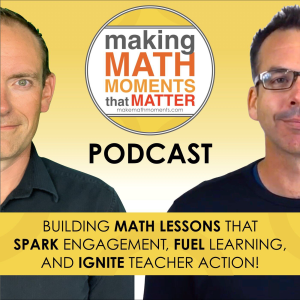
Apply to be a Featured Interview Guest
Book a Mentoring Moment Coaching Call
Are You an Official Math Moment Maker?
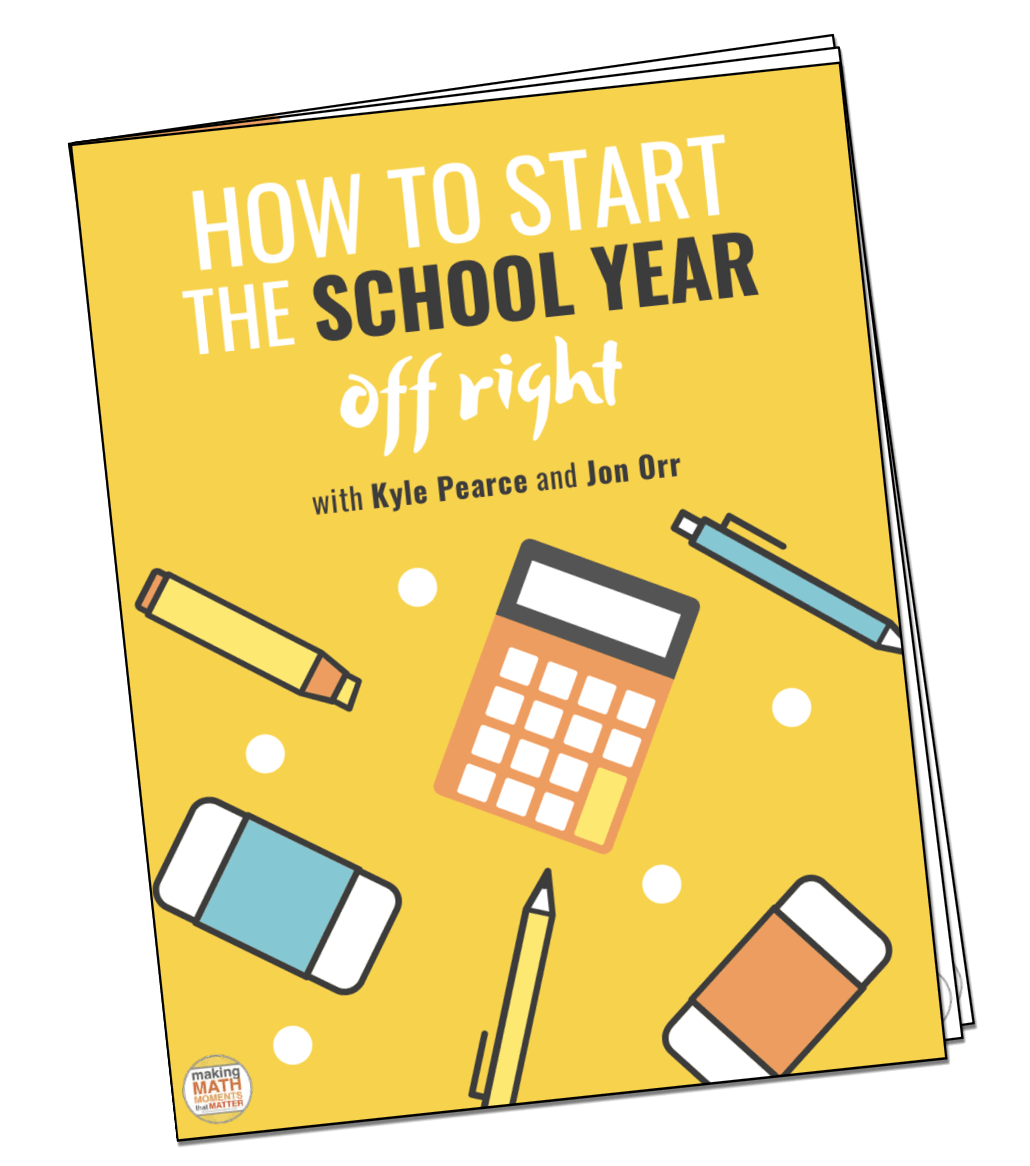
FULL TRANSCRIPT
Jon Orr:
All right, let’s talk about sustainable structures for lifelong learning. Because the question posed here is, and this is something for us to ponder, as a district leader, a math coordinator, a math coach, I want you to ponder this question. And the question is, are we developing a sustainable structure for lifelong learning around mathematics for the people that we’re supporting? Or are we building a compliance-driven PD calendar. And I think that’s the big question we want to talk about here today, because we talk every single day with math coordinators, math coaches across North America and the world around their structures, around what they’re doing to support learning in the classrooms, to support the wonderful educators that are working with students every day. And we see the gambit. We see teachers and coordinators and coaches supporting or trying to create sustainable models where we are encouraging growth and continued lifelong learning. But we’re also seeing like, this is the way that we want this done. And this is the way it needs to get done. And this is the calendar that’s going to help us get there. And thou shalt all do this strategy. So we see like both sides of like what’s what people are trying to do. And there are there are, you know, People believe strongly on both ends of like this kind of, in a way, this spectrum of the way that we should be trying to support and encourage change in mathematics instruction for our students. So let’s dig in, guys. What’s some of the research say?
Yvette Lehman:
I think you brought up a good question. I like how you said, you let’s ponder this. I don’t know that we have the answer today or, or that we’re going to, you know, solve all of these problems. But I like the idea that you mentioned about, know that there’s research out there. There’s sound research in any, in some cases, people might say, we know what best practice looks like in mathematics. And now that we know what best practice looks like and sounds like, we just need to do it. Teachers just need to do it.
Jon Orr:
Right. Just do it.
Yvette Lehman:
And so that’s where we find ourselves in a situation. And I recently read an article that was published. this was back in 2021. So if Jim Knight has changed his position on this topic, you know, reach out to us, we’d love to debate it. But in this particular article, it was from the learning professional from learning forward. And he talked about the distinction between outside in PD and inside out PD. So outside in PD is what we were just describing, which is basically this compliance driven These are the best practices. know that this is what we should be doing to have a positive impact on student achievement. Do it.
Kyle Pearce:
Yeah, not going to waste any time. Just get to work, get it done, and let’s go.
Jon Orr:
Right, yeah. You know what, exactly, you know what these are. It’s like we kick off, the kickoff day’s in August. We’re going to bring in guest speakers on best practices and we’re going to model it, we’re gonna talk about it, and we’re gonna say like, this is what we expect to see in our classrooms when we come do walkthroughs.
Yvette Lehman:
And in this article, what Jim argues is that that approach of outside in compliance driven professional development rarely has an impact on the classroom. Like we rarely see it transfer to significant shifts in practice just because I heard somebody tell me that this was the best practice or I should be doing it this way.
Jon Orr:
Right, right, yeah. Like I think, you know, people are nodding their heads right now as well. It’s like they have been butting their heads up against, you know, teachers who are say resistant to change or also going like they weren’t resistant to change, but I just don’t see it consistently happening in the classroom when I thought we, you know, this made sense to them. And it could be in a one-on-one coaching environment, it could be your PLCs, it could be in your large scale pull-outs, but I think we often see that we don’t have, and I’m going to use words that people tell us all the time, is that I don’t see buy-in on the strategy we’re trying to say or the strategies we’re trying to see in our classroom to support students in best practices for mathematics learning.
Kyle Pearce:
Well, you know, it’s interesting that like somehow along the way we thought that that might work, you know, like I think we’ve all found ourself there. I’ve done it. You know, I’ve I’ve event you’ve been, you know, in the same spot. We’ve co planned these types of events. Well, I was just going to say like, John, this is exactly what I was going to go to is say like in the classroom, when have we ever just lectured at students and basically like shown them the mathematics and then like the entire group is like good to go ready to rock like no like they need the support they need the purposeful practice they need to experience this work and typically in the outside in style or format of PD it tends to be the one and done right and then even if it’s not one and done like even if it’s like we’re gonna do like you know a series you know and like maybe for you know a couple times in the semester this speaker is going to come back to share really that outside in PD is really most helpful, I think for awareness. So it’s like, it’s like, this exists. Like, you know, this, this might be something that we might want to strive for, but I don’t necessarily know how to do it tomorrow. And just because I’m going to think a little bit more about it over the weekend or over the summer doesn’t mean I’m going to be able to feel confident and ready to change what I’m doing in my classroom in order to sort of reach the same sort of experience or approach that maybe was being presented in this outside in PD. So, you know, I’m really eager here to kind of dig in. And I want to say, I’m going to just put my foot down. I don’t care about you two. I don’t care about you two, but I’m not going to say that outside in PD can’t be helpful at times. Right. But let’s dig in here and event like break down for us like what would be the opposite of outside in PD and what I believe you know Jim Knight is saying is probably the one that we want to be focusing more of our time and attention on.
Yvette Lehman:
So the article suggests that let’s imagine we’re trying to implement high impact strategies, that we can still lead teachers to the implementation of those strategies by putting them in the position to identify the problem, by unpacking student thinking, and then through the support of a skilled facilitator in seeking solutions to the challenges that they’re facing in their classroom, we can actually encourage the implementation of these strategies that are going to have a positive impact, but it’s directly in response to what they’re teaching and the students in front of them. Rather than being this, you know, well, this is the best way to do it, so now just go and do it. And it feels completely disconnected from the learning that’s happening in their classroom today and tomorrow. But if we start with the learning, with the unit that they’re currently, right, like what they’re currently working on,
Jon Orr:
problems of practice.
Yvette Lehman:
But in order for this inside out approach to work where it’s teacher driven and response to student data based on what they’re currently teaching in their classroom at this time, so it’s timely, it’s relevant, we have to have structures in place for collaboration. We have to value teacher collaboration and create space for it. And we also arguably need the support of a skilled facilitator to guide us toward those research-based approaches.
Jon Orr:
sure, for sure. And it’s like, it’s, people are not in their heads, like, like, it’s a no no brainer. Because in a way, like, this is what we were doing in our math classrooms for the last 10 years is trying to position students to be in a curious moment or a curious position to generate problems that they want to solve, or steer them to two problems that they want to solve, or want to know the answers or be be more curious. This is part of our, our three-part framework for math lessons is if we can get our students in that position to be like, I’m really curious about how to get from here to here, and I want to take a step forward, but I don’t know how to get there, then that’s where the skilled facilitator gets to navigate that situation and help a kid develop the skills or develop the ideas or the connections to help get over that hump. And then they have that internalized process of like, I did this. This is what we were doing in our classrooms, which is what we need to be doing with our educators. It also reminds me of that, you know, the book Switch, we talked about this, we talked about this a lot on the podcast and also in our calls about motivation. You know, like if you’re coming at it from, shalt do this, or you know, we think this is good. What you’re doing is you’re hitting one of the three areas that you need to hit when you’re trying to help someone change. And those three areas is like, usually when you’re like, this outside in approach is really addressing probably the rider in the rider, elephant pathway analogy, which means like you’ve got this elephant, there’s a rider on top of the elephant, you’re in the forest or jungle or something, and you’re trying to move down this pathway, at the end of the pathway is change. The rider is like the logic part. And I think we try to do that in that outside in. It’s like, logically, this makes sense. Look, we can show you this makes sense. Here’s what it could look like. Here’s the reason, you know, and then the pathway, you have to clear that pathway, which is the second part. Sometimes we do that. Here’s a resource that can help you get there. But the part you’re missing, which is the part that the inside out method addresses is the elephant, which is the bigger component, because if the elephant doesn’t wanna go down the pathway, you’re not going. Which is the fears, our problems, our emotional side of our brains that we have to account for. And I think that’s the part that you’re talking about, or Jim Knight’s talking about in the inside out, which means we need teachers to be like, here are my problems of practice, or here’s a content area that I’ve been struggling at that I just wish that I could pluck this pebble from my shoe. Like we have to come at the support we provide by addressing the elephant and then the rider and then clear the pathway.
Kyle Pearce:
Well, you know, and I think the first thing that comes to mind. again, yes, it seems logical, but boy, boy, that seems like hard work, you know? And I think what we end up doing, I always, I always make the comment that, you know, as humans, we are sort of like the dumbest smart creature there is out there, you know? And why I say that is because we know from the data, we know that if We bring in the outside in PD and we bring in the speaker and we try to, we’re constantly utilizing that model in our minds, even though the data is telling us that we’re not going to actually see the results we’re after. We’re not going to see implementation. We still do it because it seems like it’s more efficient, you know, and you’ll look at it you go, if I just book and you know, book a big hall and bring everybody together and like, and we’ll make sure everybody’s experience this thing. It’s like what we’ve really done is we’ve accomplished an awareness piece, and really nothing more. And I think one of the big challenges, this is where I think a lot of listeners are probably listening and going like, how do we get started knowing what we know, when budget or time or resources are limited, inside our schools or grade bands or in our districts. How like how do we go about trying to actually take what we know is is is reality what we know is true what we know is most effective and actually allow ourselves to I guess be given the grace that this will take time and it’s not going to be a problem we solve overnight like how do we help people take steps in that direction so they can start doing something that will actually be making some sort of impact along this journey.
Yvette Lehman:
think, John, you already made the analogy or the connection to the approach we take in the classroom, which is like what you just described, Kyle, is exactly like rushing to the algorithm. It’s like we can teach the algorithm upfront because that’s probably faster and more efficient, but we know the lasting impact is minimal. And that’s the same for this approach for professional development. So your question, Kyle, was how do we do this with limitations? Well, I guess what I would say back is what if you don’t do it? And if you don’t, you’re going to keep having the same results that you’re currently having and you’re likely going to have very little change. So let’s unpack some strategies for overcoming maybe some of those barriers that you identified.
Jon Orr:
Yeah, well, totally.
Kyle Pearce:
If you’re watching on YouTube, John’s like squirming around over there. He wants to hop in here.
Jon Orr:
Well, I was going to say, sometimes it’s because there are pathways forward. We are identifying that the inside out method with accommodation, and we’ll talk about maybe what that exactly looks like here with the outside in method as a source to move things along. But there are pathways forward for this fractal way of using those two in combination from the district level down to, say, the school level down to, say, the PLC level down to the classroom level. There is research that suggests how to support teachers along this continuum using, say, the inside out approach at, say, that fractal level. in a way, there’s the pathway forward. I think what we need to decide when we’re in schools or in school districts is the expected outcome and get real about the level of commitment we’re going to commit to achieving the results we want. Because I think what’s happening is like, We all want change to happen, but because there is this very carefully crafted pathway to get change, it does require, like you’re saying, Yvette and Kyle, it does require resources like one-on-one support resources, like dedication for collaboration, like appropriate time committed to making all of this happen. A coordinated effort is there, but we have to as at the school level or the district level have to decide where the priority is and what priorities that we can commit to achieving that. we have the pathway, which we do, can we commit to that? And if we do commit at this level, because there’s an ideal, and I think we just know that there’s no budget for the actual ideal, because if there, you know, we can’t say have one-on-one coaches for every single teacher, every single week, or every single day. We can’t have, say, collaboration happening all this time. But we do have to then decide, what can we commit, knowing that these are good practices to create change, and then get real on what actual results will happen, and then being OK with that plan forward? Because I think that’s where the mismatch right now is happening, is that we are just out of whack on like, what is commitment level is needed to achieve the dream expectations we think is gonna happen when we do an outside in approach.
Kyle Pearce:
Right, right. And I think basically what you’re saying is that I think we have to get real with what it is that we truly want to accomplish and actually set out to figure out a way to do that work. And that means taking the responsibility that we’re going to have to measure that and we’re going to have to name it specifically. We’re going to have to be able to know what that looks like if we get that goal and we’re not talking about fixing all of mathematics problems or all of education’s problems we’re talking about actually taking a bite sized a realistic bite sized chunk into a challenge so that we can actually make some real progress instead of essentially because we talk about limited resources but like we still are spending the money and we’re just spinning our wheels doing things and doing things and doing things but not really knowing what sort of result we’re going to get. see standardized tests aren’t really changing. So we know that’s not happening. But then if we even zoom in a little bit closer, we’re not actually seeing any of the changes that we had set out to achieve. And in many cases, it’s because we haven’t really identified specifically enough what those changes are that we want to be looking for.
Yvette Lehman:
So maybe where we need to start is just to make a commitment to ourselves, which is we are going to be mindful of the compliance-driven PD calendar thou shalt, whether you like it or not, implement or, you know, leverage these strategies. So we’re gonna be very mindful of that type of thinking. And then also strive in every way that we can to create a system that inspires lifelong learning that puts the teacher in the driver’s seat. And we always say this about the classroom, you know, the person doing the talking is doing the thinking. The person identifying the problem and digging in is doing the learning. So we know that that’s a model that we need to replicate for our adult learners as well, where they’re the ones doing the talking, they’re the ones unpacking and doing the thinking and digging in with support from a knowledgeable other or skilled facilitator. I think that part is key. So you mentioned There’s no way, you know, most districts have the time or funds, even just thinking about the release time from the classroom that it would take, you know, the time away from students to really dig into this work. So what is realistic or bite sized or appropriate to start to put some of these conditions into place? One idea that I’ve been thinking through lately is, you know, let’s imagine the junior curriculum, my favorite curriculum. There is no way you could develop a professional development model to help teachers dig into and unpack every concept in the junior curriculum. Like if you can, that’s amazing. If you have an abundance of collaboration time and coaching support, wonderful. But the reality is it’s probably not going to happen in most districts. So what is, and some districts do this, right? They identify a key concept. They’re like, we’re going to tackle this key concept this year and you know we’re not going to strengthen every single unit teachers engage in or interact with but we’re going to strengthen these key concepts. Is there a place is it more realistic to say that by the end of this year our junior teachers our fourth through sixth grade teachers let’s say are going to strengthen their understanding of strategies to support multiplication and division and we’re going to give them you know, these structures that are collaborative in nature. So it’s not like they’re all going to come out to a big release, 50, a hundred people in a ballroom. And I’m going to front load them with all of these different multiplication strategies that they’re likely not going to then take back and transfer to the classroom next week. But I think that maybe the strategy is like, we talk about this all the time, like fewer grades, a more narrow focus. using your data to identify where are the pockets of opportunity within your district? Like are you targeting eighth grade because you see that the transition from eighth to ninth is problematic and you know that that’s an area to target. Are you targeting fourth and fifth because you know that by the time your standardized test comes in sixth, students are demonstrating significant gaps? Strategically identifying pockets to target, but with the goal of not only strengthening teaching and learning, but establishing a culture where teachers are inspired and empowered to do more learning on their own because they have a taste of it. Like they’ve been put in situations where they are empowered. They are the ones who can find the solutions with support. It’s not always people from above, people from the board, people from outside coming in and telling them how to do it.
Kyle Pearce:
Hmm. I love that. And you know, I think as you get more narrow and you do what you can do, right? So if we plan based around what is possible and we create a structure and an opportunity for us to do some of the learning within that structure, when we get more narrow, there’s a little bit of pressure in two ways. One pressure is, this enough? Like, are we doing enough? And the reality is, is that we know what will happen if we try to do it the other way. right? We’re not going to get any impact when we narrow down. It actually creates a little bit of accountability for everyone, including leadership, right? Where we go. This is what we’re working on. So like, let’s do this really well and let’s monitor it. Let’s refine it. Let’s keep making progress there. So I love all the suggestions you’ve given. And really what I’m hearing is we need to make it more bite size. So if someone’s saying, I don’t have resources, I don’t have time, I don’t have this, I don’t have that.
Jon Orr:
Mm-hmm.
Kyle Pearce:
Well, guess what? What you have is what you have. And that amount of time, we now need to make a decision as to how am going to use that most effectively? Or do I use it and try to use it really ineffectively? Like, let’s make it effective and let’s accept the reality that every district is going to have different resources and different opportunities to dig in here. But let’s make it make an impact when we do that work.
Jon Orr:
Yeah, like, I think you’ve nailed it, right? Like, this narrowness is basically saying, like, yes, like, if you had unlimited resources, unlimited funds, unlimited support, you could design it following that pathway. But when you have, say, your unique constraints, it’s, how can I do some of that? Like, how can I dead, like which grade level could I target to have say, one on one continued follow up coaching and also have the collaborative support at the PC level and also get what everyone else gets at say those large school pullouts and all those things are coordinated. Like, we have resources in every district we’ve talked to, we can always do that at some level, which is where your pathway for success and support is following that inside out method with say outside in as say a source for say new ideas when we need new ideas after we’ve identified targets that we do want to say strengthen and we realized, hey, we don’t have what it takes to hit that target. want to say get say outside help here to help us fix that gap. We can always dedicate resources to follow that path. It’s just the scale is different depending on your resources available, which then just says, well, if that’s my scale, I can go down this pathway, then I’m going to see results with that small group. And that’s the results I’m going to use as like, it worked. I’m seeing impact in this area. I’ve got grade levels changing. I’m like, maybe in a couple of years, I’m going to see that that changes into standardized test result changes as well. And then stop measuring, you know, not to stop measuring, but stop comparing or using other measurements that aren’t that to dictate whether you’re on the right path or not.
Kyle Pearce:
I love that, John. So friends, listen, if you are interested in figuring out where you might focus your time and attention on next, you should head on over to makemathmoments.com forward slash report, and you can dig in to understand where things are going well and where you might wanna focus your attention on currently so that you can take your very unique situation and create a plan that will have an impact.
Thanks For Listening
- Book a Math Mentoring Moment
- Apply to be a Featured Interview Guest
- Leave a note in the comment section below.
- Share this show on Twitter, or Facebook.
To help out the show:
- Leave an honest review on iTunes. Your ratings and reviews really help and we read each one.
- Subscribe on iTunes, Google Play, and Spotify.
DOWNLOAD THE 3 ACT MATH TASK TIP SHEET SO THEY RUN WITHOUT A HITCH!
Download the 2-page printable 3 Act Math Tip Sheet to ensure that you have the best start to your journey using 3 Act math Tasks to spark curiosity and fuel sense making in your math classroom!
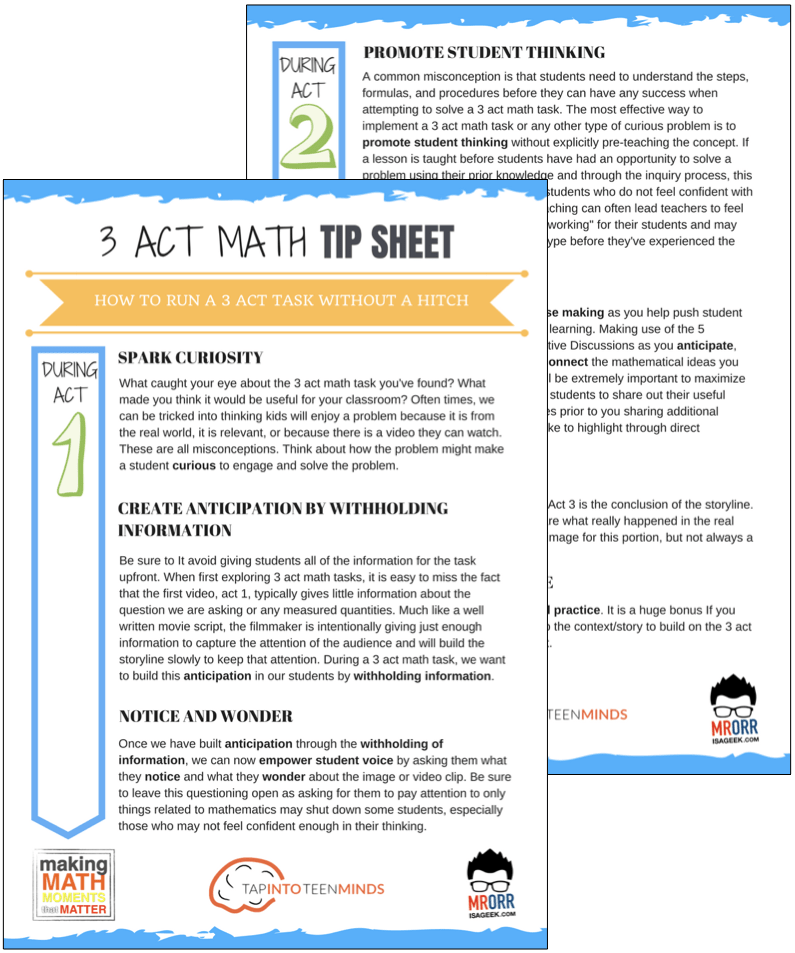
LESSONS TO MAKE MATH MOMENTS
Each lesson consists of:
Each Make Math Moments Problem Based Lesson consists of a Teacher Guide to lead you step-by-step through the planning process to ensure your lesson runs without a hitch!
Each Teacher Guide consists of:
- Intentionality of the lesson;
- A step-by-step walk through of each phase of the lesson;
- Visuals, animations, and videos unpacking big ideas, strategies, and models we intend to emerge during the lesson;
- Sample student approaches to assist in anticipating what your students might do;
- Resources and downloads including Keynote, Powerpoint, Media Files, and Teacher Guide printable PDF; and,
- Much more!
Each Make Math Moments Problem Based Lesson begins with a story, visual, video, or other method to Spark Curiosity through context.
Students will often Notice and Wonder before making an estimate to draw them in and invest in the problem.
After student voice has been heard and acknowledged, we will set students off on a Productive Struggle via a prompt related to the Spark context.
These prompts are given each lesson with the following conditions:
- No calculators are to be used; and,
- Students are to focus on how they can convince their math community that their solution is valid.
Students are left to engage in a productive struggle as the facilitator circulates to observe and engage in conversation as a means of assessing formatively.
The facilitator is instructed through the Teacher Guide on what specific strategies and models could be used to make connections and consolidate the learning from the lesson.
Often times, animations and walk through videos are provided in the Teacher Guide to assist with planning and delivering the consolidation.
A review image, video, or animation is provided as a conclusion to the task from the lesson.
While this might feel like a natural ending to the context students have been exploring, it is just the beginning as we look to leverage this context via extensions and additional lessons to dig deeper.
At the end of each lesson, consolidation prompts and/or extensions are crafted for students to purposefully practice and demonstrate their current understanding.
Facilitators are encouraged to collect these consolidation prompts as a means to engage in the assessment process and inform next moves for instruction.
In multi-day units of study, Math Talks are crafted to help build on the thinking from the previous day and build towards the next step in the developmental progression of the concept(s) we are exploring.
Each Math Talk is constructed as a string of related problems that build with intentionality to emerge specific big ideas, strategies, and mathematical models.
Make Math Moments Problem Based Lessons and Day 1 Teacher Guides are openly available for you to leverage and use with your students without becoming a Make Math Moments Academy Member.
Use our OPEN ACCESS multi-day problem based units!
Make Math Moments Problem Based Lessons and Day 1 Teacher Guides are openly available for you to leverage and use with your students without becoming a Make Math Moments Academy Member.
Partitive Division Resulting in a Fraction
Equivalence and Algebraic Substitution
Represent Categorical Data & Explore Mean
Downloadable resources including blackline masters, handouts, printable Tips Sheets, slide shows, and media files do require a Make Math Moments Academy Membership.
ONLINE WORKSHOP REGISTRATION
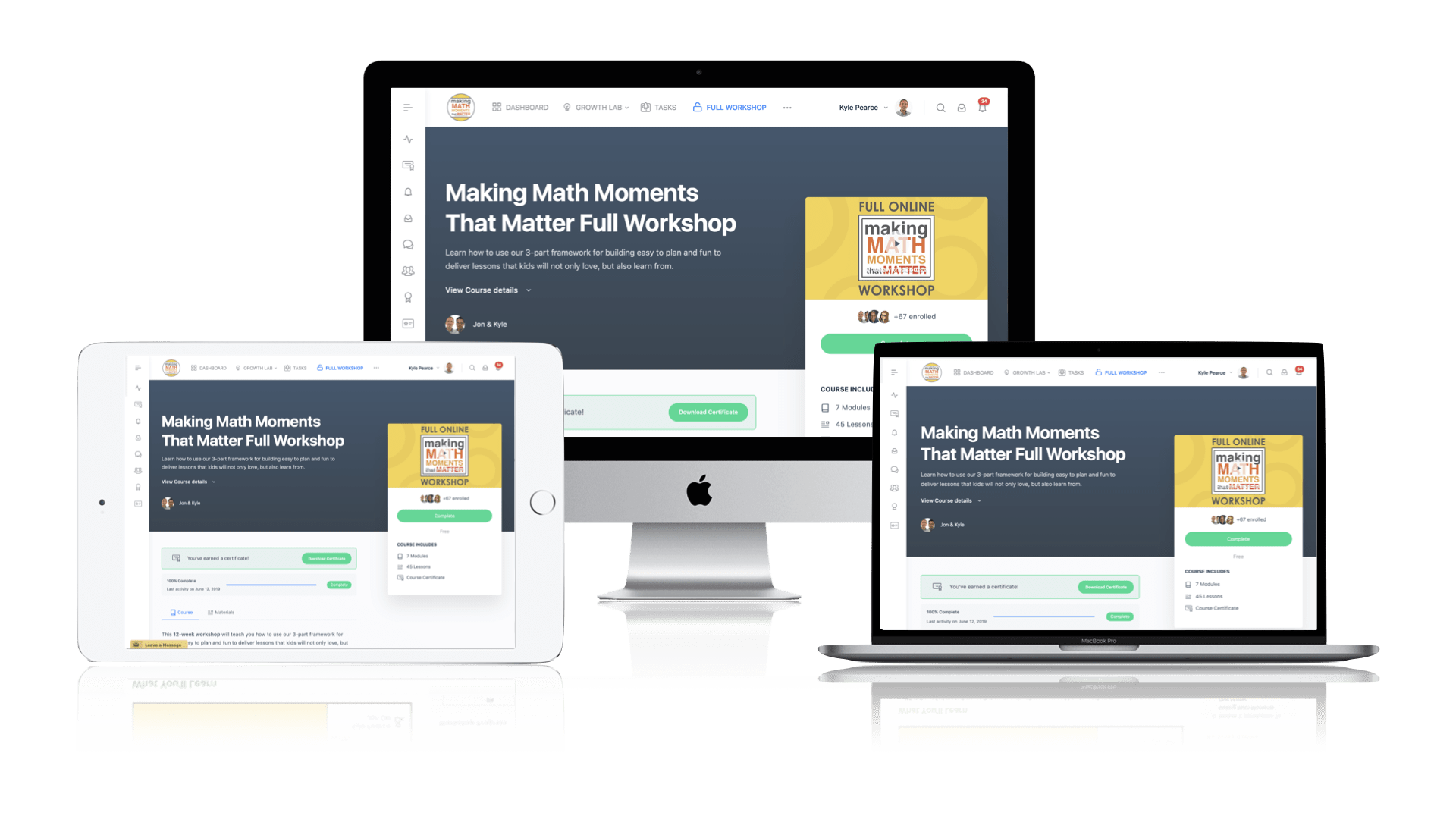
Pedagogically aligned for teachers of K through Grade 12 with content specific examples from Grades 3 through Grade 10.
In our self-paced, 12-week Online Workshop, you'll learn how to craft new and transform your current lessons to Spark Curiosity, Fuel Sense Making, and Ignite Your Teacher Moves to promote resilient problem solvers.
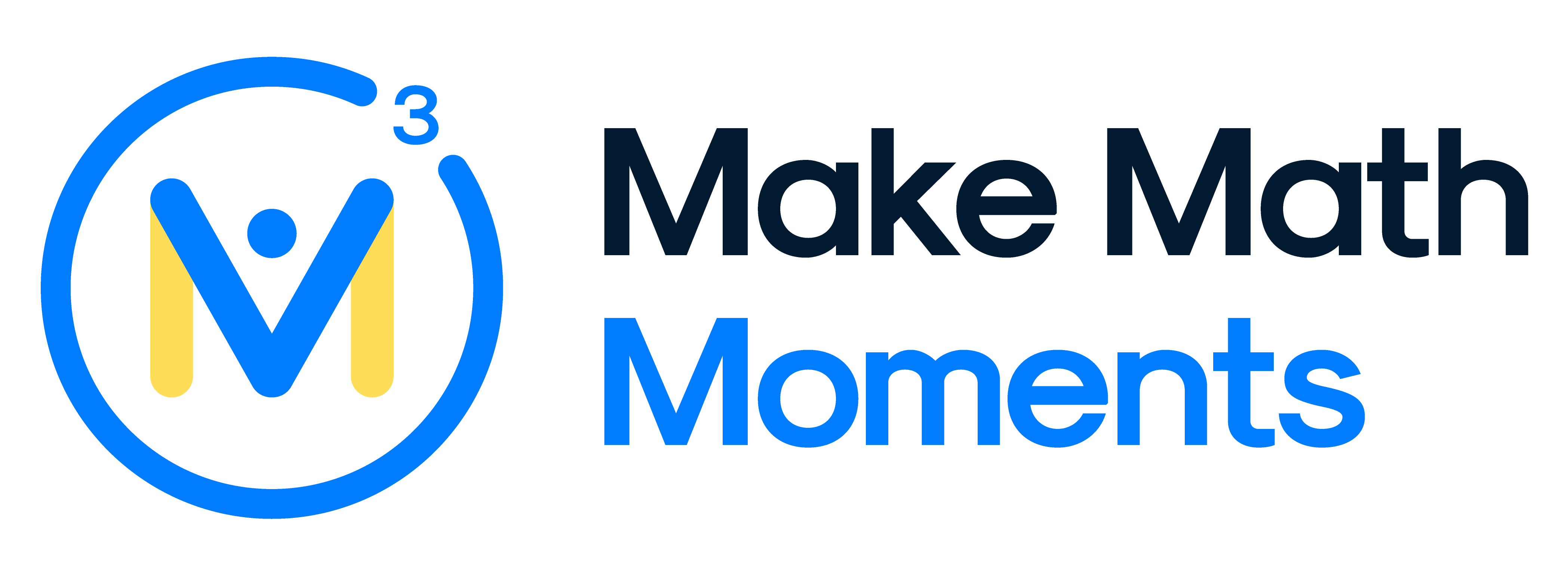



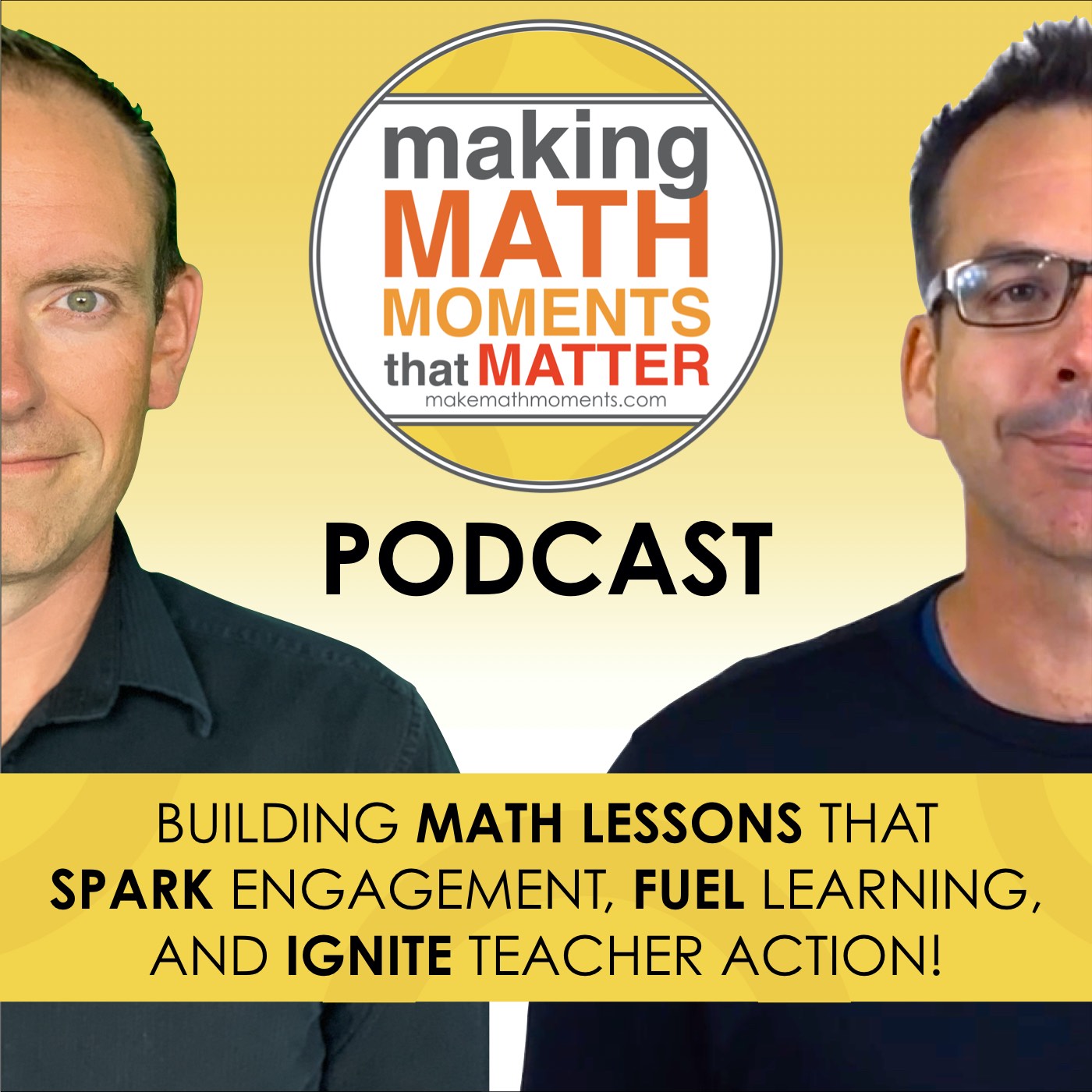
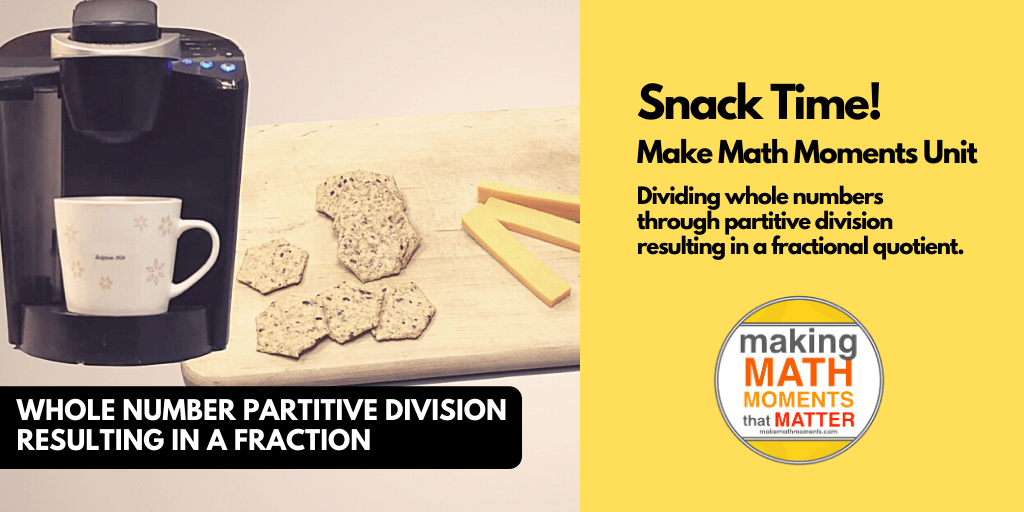

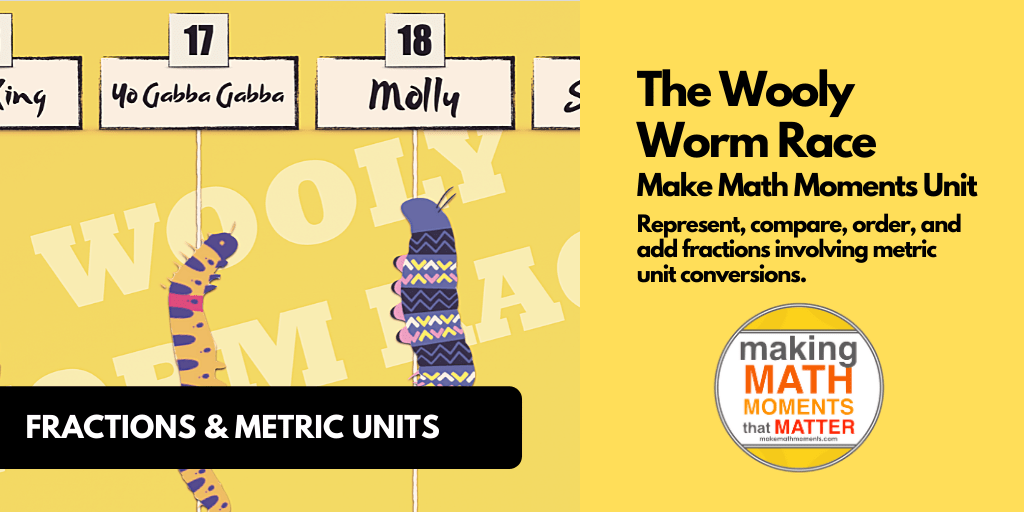
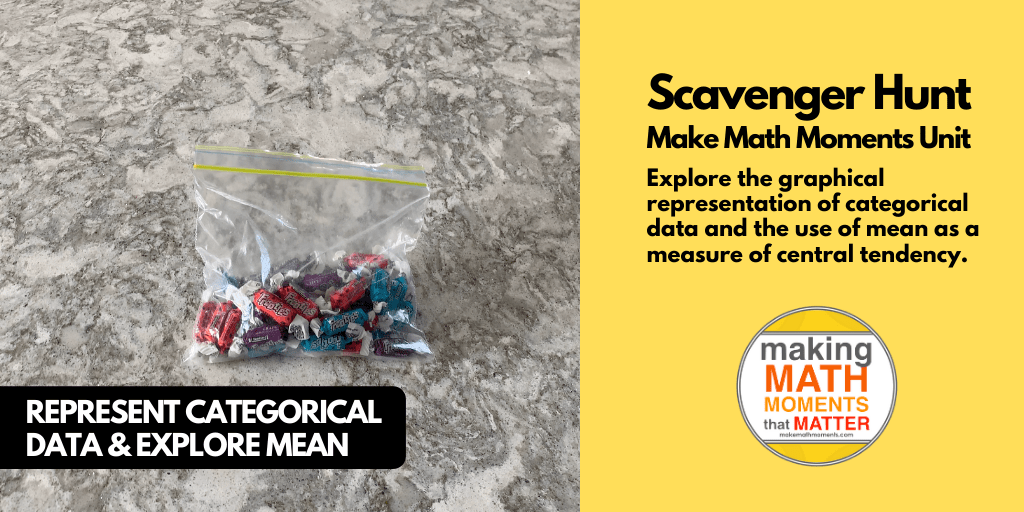
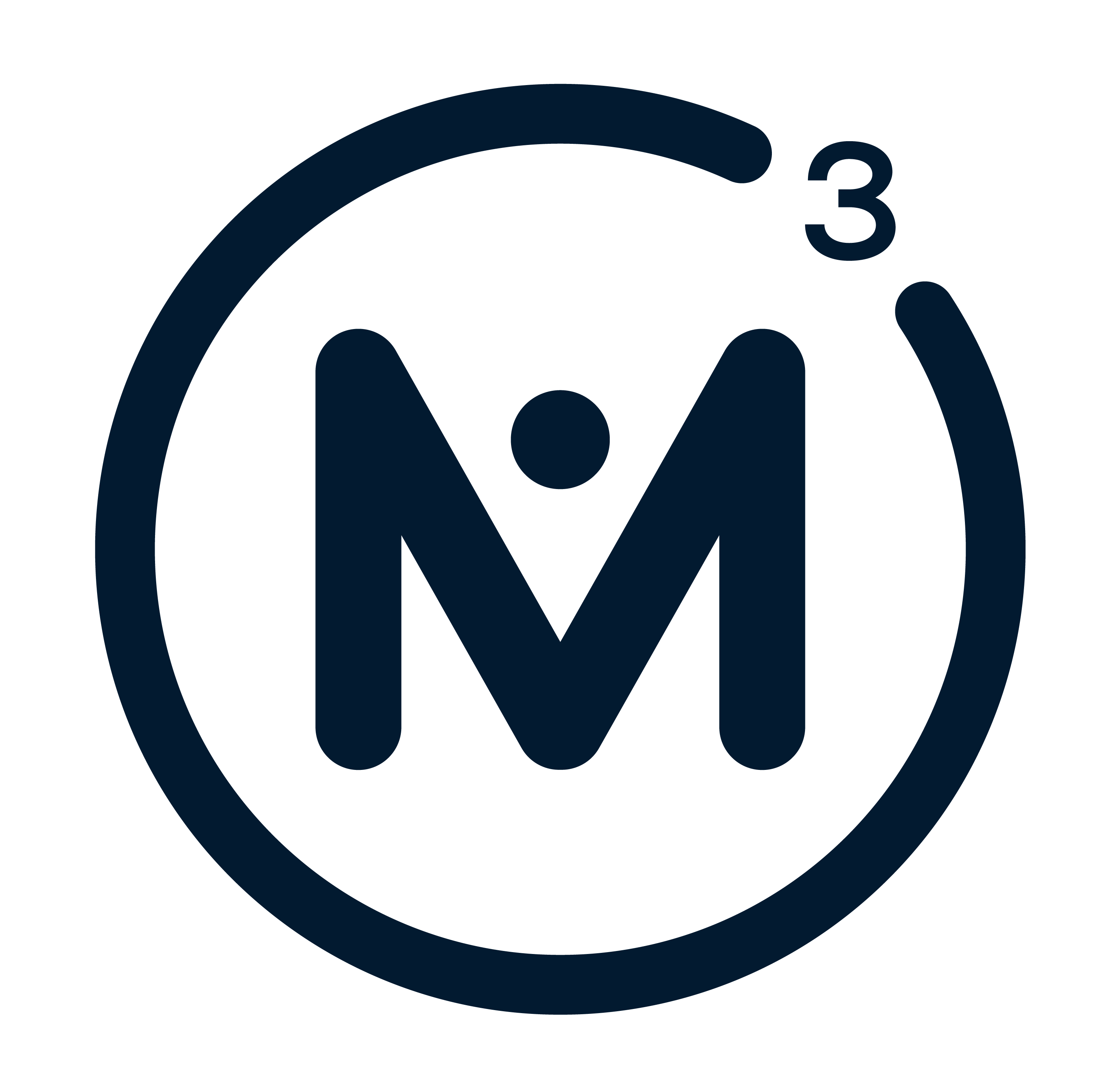
0 Comments